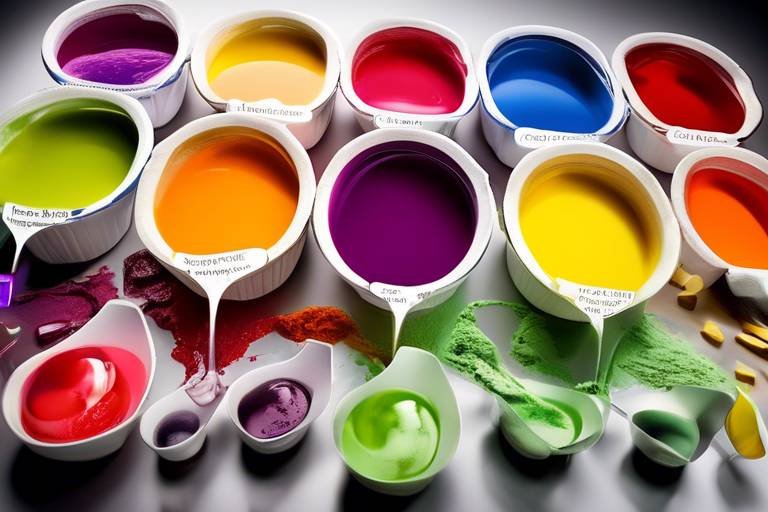The Chemistry of Food Colorings - What to Look Out For
Food colorings are an integral part of our culinary landscape, adding vibrancy and appeal to a wide range of products. But have you ever stopped to think about what goes into those eye-catching hues? The chemistry behind food colorings is a fascinating journey through both nature and science, revealing a world where aesthetics meet health considerations. In this article, we will explore the different types of food colorings, their chemical compositions, and the potential health effects that consumers should be aware of when making choices about the foods they eat. Are you ready to dive into this colorful world?
Food colorings can be broadly categorized into two main types: natural and synthetic. Each type has its unique characteristics, benefits, and challenges. Understanding these differences is crucial for consumers who want to make informed choices about what they put into their bodies. Natural colorings come from sources like plants and minerals, while synthetic colorings are chemically manufactured. But what does this mean for your health and the foods you consume? Let’s take a closer look.
Natural colorings are derived from various sources, including plants, vegetables, and minerals. Some popular examples include beet juice, which provides a deep red color; turmeric, known for its bright yellow hue; and spirulina, a blue-green algae that adds a vibrant touch to foods. The appeal of these natural options lies in their perception as healthier alternatives. Many consumers believe that natural colorings are less harmful and more beneficial than their synthetic counterparts. However, it's essential to consider both the benefits and limitations of these natural colorants.
One of the primary advantages of natural food colorings is their perceived health benefits. They often contain antioxidants, which can contribute to overall health. Additionally, natural colorings are generally less likely to cause allergic reactions compared to synthetic dyes. This makes them a popular choice for health-conscious consumers and those with sensitivities. Imagine a world where your food not only looks good but also nourishes your body—this is the promise of natural colorings!
Despite their many benefits, natural colorings come with their own set of challenges. For instance, they can exhibit variability in color intensity, meaning the shade of a product may change from batch to batch. Furthermore, natural colorants may not hold up well under heat or light, leading to fading or changes in hue over time. This instability can be a significant concern for food manufacturers who strive for consistency in their products. So, while natural colorings are appealing, they aren't without their hurdles.
Natural colorings can be extracted from a variety of sources, including:
- Fruits: Such as berries, which offer rich colors like red and blue.
- Vegetables: Like carrots and beets, providing vibrant oranges and reds.
- Spices: Turmeric and paprika are popular for their intense colors.
These sources undergo processing to extract the colorants, making them suitable for use in food products. Understanding where these colorings come from can help consumers appreciate the natural origins of their food.
On the other hand, synthetic food colorings are chemically manufactured and widely used in the food industry. These dyes offer a range of vibrant colors that are often more stable than natural options, making them a popular choice among food manufacturers. However, their safety has been a hot topic of debate. Many consumers are concerned about the potential health risks associated with synthetic dyes, particularly regarding their effects on children and overall health.
Research has raised questions about the safety of synthetic food colorings, with some studies suggesting links to hyperactivity in children and other health issues. While the scientific community continues to investigate these claims, it’s vital for consumers to be aware of the ongoing debates surrounding synthetic colorants. Are these artificial colors worth the risk, or is the allure of vibrant food too tempting to resist?
Food colorings, whether natural or synthetic, are subject to strict regulations to ensure consumer safety. Regulatory bodies like the Food and Drug Administration (FDA) in the United States oversee the use of food colorings, establishing safety standards that manufacturers must adhere to. This regulatory framework plays a crucial role in food production and labeling, helping consumers make informed choices. Understanding these regulations can empower you as a consumer to choose products that align with your health values.
Q: Are natural colorings always better than synthetic ones?
A: Not necessarily. While natural colorings are often perceived as healthier, they can have limitations in terms of stability and color intensity. It's essential to consider both types based on your specific needs.
Q: How can I tell if a product contains synthetic colorings?
A: Check the ingredient list on food packaging. Synthetic colorings often have names like "Red 40" or "Yellow 5," while natural colorings are usually identified by their source, like "beet juice" or "turmeric extract."
Q: Are there any regulations on food colorings?
A: Yes, food colorings are regulated by agencies like the FDA, which establishes safety standards to protect consumers. Always look for products that comply with these regulations.

Types of Food Colorings
This article explores the various types of food colorings, their chemical compositions, potential health effects, and considerations for consumers when choosing food products that contain these additives.
When it comes to food colorings, there are two primary categories that stand out: natural and synthetic. Understanding these distinctions is crucial for consumers who want to make informed choices about what they put into their bodies. Natural colorings are sourced from the earth—think fruits, vegetables, and even minerals—while synthetic colorings are created in laboratories, often with a complex array of chemicals. This dichotomy raises an important question: which is better for our health? The answer isn't as straightforward as one might think.
Natural food colorings have gained popularity in recent years, often marketed as healthier alternatives. These colorings boast impressive origins, derived from sources like beet juice, turmeric, and spirulina. For instance, beet juice can impart a vibrant red hue, while turmeric adds a warm yellow tone. However, it's essential to consider that natural colorings can vary in strength and stability, depending on factors like the way they're processed and the conditions under which they're stored. This variability can lead to inconsistencies in food products, which may frustrate both manufacturers and consumers alike.
On the other hand, synthetic food colorings are ubiquitous in the food industry. These artificially created dyes are often more stable and consistent than their natural counterparts, making them a go-to choice for many food manufacturers. However, the use of synthetic dyes has sparked significant controversy over the years. Some studies have linked these chemicals to potential health risks, including hyperactivity in children and various allergic reactions. This ongoing debate raises the question: should we trust these brightly colored foods, or should we be cautious about their ingredients?
To better understand the differences between natural and synthetic food colorings, let's take a look at the table below:
| Type of Food Coloring | Source | Stability | Health Concerns |
|---|---|---|---|
| Natural | Fruits, vegetables, minerals | Variable | Generally low |
| Synthetic | Chemically manufactured | High | Potential health risks |
As consumers, it's essential to weigh the pros and cons of each type of food coloring. While natural colorings are often perceived as the healthier option, they come with limitations that can affect food production. Conversely, synthetic colorings may offer consistency and stability but raise concerns about long-term health effects. So, which side of the spectrum do you lean towards? Are you more inclined to trust nature, or do you prefer the reliability of science?
Ultimately, the choice between natural and synthetic food colorings is a personal one. It's crucial to read labels, research ingredients, and consider your health and dietary preferences. By being informed, you can make choices that align with your values and health goals.
- What are natural food colorings? Natural food colorings are derived from plants, minerals, and other natural sources, offering a more wholesome alternative to synthetic dyes.
- Are synthetic food colorings safe? While synthetic food colorings are regulated, there are ongoing debates about their safety, with some studies linking them to health issues.
- How can I identify food colorings in products? Always check the ingredient list on food packaging. Look for terms like "natural color," "artificial color," or specific dye names.

Natural Food Colorings
When it comes to adding a splash of color to our food, have gained immense popularity in recent years. Derived from various sources like plants, minerals, and even insects, these colorants provide a vibrant hue without the chemical aftertaste of their synthetic counterparts. Have you ever wondered how that beautiful red hue in your favorite beet salad is achieved? Or what gives turmeric its bright yellow color? Let's dive into the world of natural colorings and explore the benefits and limitations they bring to the table.
One of the most well-known natural colorings is beet juice, which is not only packed with nutrients but also offers a stunning deep red shade that can enhance a variety of dishes. Similarly, turmeric is celebrated for its golden-yellow color, making it a popular choice in curries and mustards. Then there’s spirulina, a blue-green algae that not only adds color but also a boost of protein and antioxidants. The allure of these natural colorings lies not just in their visual appeal but also in their health benefits. Unlike synthetic dyes, which can sometimes trigger allergic reactions, natural colorings are generally regarded as safer options.
However, it's important to recognize that natural food colorings come with their own set of challenges. For instance, their color intensity can vary significantly depending on factors like the source of the coloring and the method of extraction. Additionally, many natural colorants are sensitive to heat and light, which can lead to fading or changes in color when exposed to cooking or storage conditions. This variability can be a headache for food manufacturers who strive for consistency in their products.
Let's take a closer look at some common sources of natural colorings:
- Fruits: Berries, such as blueberries and raspberries, are often used for their vibrant colors.
- Vegetables: Carrots and spinach can provide a range of hues from orange to green.
- Spices: Paprika and saffron are not only flavor enhancers but also excellent colorants.
To extract these colorants, manufacturers typically use processes like juicing, drying, and grinding. The result? A natural coloring agent that can be used in everything from candy to sauces. However, the challenge remains: how to maintain the vibrancy and stability of these colors throughout the production and shelf life of the product. This ongoing quest for stability is what keeps researchers and food technologists busy, as they explore innovative ways to harness the power of nature while ensuring that our food looks as good as it tastes.

Benefits of Natural Colorings
When it comes to adding a splash of color to our foods, natural colorings have gained significant popularity in recent years. One of the most appealing aspects of these colorants is their perception as healthier alternatives to synthetic options. Derived from plants, fruits, and vegetables, natural colorings not only enhance the visual appeal of food but also often bring along a host of beneficial properties. For instance, many natural colorings are rich in antioxidants, which can help combat oxidative stress in the body. This is a fantastic bonus, as we are not just eating with our eyes but also nourishing our bodies.
Moreover, natural colorings tend to be less allergenic compared to their synthetic counterparts. Many consumers are becoming increasingly aware of food allergies and sensitivities, and the use of natural colorings can significantly reduce the risk of adverse reactions. For example, while synthetic dyes like Red 40 have been linked to hyperactivity in some children, natural alternatives such as beet juice provide a vibrant hue without the associated health concerns. This aspect makes natural colorings particularly appealing for parents looking to provide safe and healthy options for their children.
Another benefit worth mentioning is the environmental impact. Many natural colorings are derived from sustainable sources, which means they often have a smaller carbon footprint compared to synthetic dyes that are manufactured through chemical processes. By choosing products with natural colorings, consumers can feel good about supporting environmentally friendly practices. Additionally, the versatility of natural colorings allows them to be used in a variety of food applications, from beverages to baked goods, making them a favorite among food manufacturers aiming to meet the growing demand for cleaner labels.
However, it's essential to recognize that while natural colorings have their advantages, they are not without limitations. For instance, the variability in color intensity can sometimes pose a challenge for manufacturers who require consistent coloring in their products. Factors such as the source of the coloring, processing methods, and even seasonal variations can affect the final hue. Despite these challenges, the benefits of natural colorings still make them a compelling choice for those mindful of their health and the environment.
In summary, the benefits of natural colorings are multifaceted. They provide not only a vibrant aesthetic to our food but also come packed with health benefits, lower allergenic potential, and a reduced environmental impact. As consumers become more health-conscious and demand transparency in food labeling, the shift towards natural colorings is likely to continue. So next time you pick up a colorful snack, consider the journey of those hues and the benefits they bring!
- Are natural colorings safe to consume? Yes, in general, natural colorings are considered safe, especially when derived from food sources like fruits and vegetables.
- Do natural colorings have the same intensity as synthetic colorings? Not always; natural colorings may vary in intensity and stability, which can affect their use in certain applications.
- Can natural colorings cause allergic reactions? They are less likely to cause allergic reactions compared to synthetic dyes, but some individuals may still react to specific natural sources.
- Where can I find food products with natural colorings? Many health food stores and brands focused on clean eating offer products made with natural colorings. Always check the ingredient labels!

Limitations of Natural Colorings
While natural food colorings are often hailed as the healthier alternative to synthetic dyes, they come with their own set of challenges that can complicate their use in food products. One of the most significant limitations is the variability in color intensity. Unlike synthetic dyes, which can provide consistent and vibrant colors, natural colorings can vary greatly depending on factors such as the source of the colorant, the growing conditions, and the extraction methods used. For instance, beet juice might produce a deep red in one batch but a paler hue in another, leading to inconsistencies that can be frustrating for food manufacturers.
Another challenge is stability. Natural colorings are often sensitive to heat, light, and pH levels. For example, turmeric, known for its bright yellow color, can lose its vibrancy when exposed to high temperatures during cooking or processing. This instability can lead to color fading in products that are meant to be visually appealing, making it a tricky balancing act for chefs and food producers alike. Imagine preparing a beautiful dish only to have it look dull and uninspiring after cooking!
Moreover, the extraction and processing of natural colorants can also affect their availability and cost. Some natural sources, like spirulina, require specific conditions for cultivation and harvesting, which can drive up production costs. This can make natural colorings less accessible for smaller businesses or local producers who might not have the resources to source these ingredients reliably.
Additionally, while natural colorings are generally perceived as safer, they can still cause allergic reactions in some individuals. For example, annatto, derived from the seeds of the achiote tree, is a common natural coloring that can trigger allergies in sensitive individuals. This adds another layer of complexity for consumers who are trying to choose the safest options for themselves and their families.
In summary, while natural food colorings come with a host of benefits, it's essential to recognize their limitations. Variability in color, stability issues, higher costs, and potential allergic reactions are all factors that consumers and manufacturers must consider when choosing how to color their foods. The quest for vibrant, appealing products continues, and understanding these limitations is crucial for making informed decisions in the kitchen and at the grocery store.
- Are natural food colorings always better than synthetic ones?
While natural colorings are often perceived as healthier, they can have limitations such as variability and stability issues. It's essential to weigh the pros and cons of each type. - Can natural colorings cause allergic reactions?
Yes, some natural colorings can trigger allergic responses in sensitive individuals. It's important to read labels carefully. - How do manufacturers ensure color consistency with natural colorings?
Manufacturers may use blends of different natural colorings or adjust processing methods to achieve more consistent results. - Are there regulations for natural food colorings?
Yes, natural food colorings are subject to regulations, though they may differ from those governing synthetic colorings. Always check for compliance with local food safety standards.

Common Sources of Natural Colorings
When it comes to natural food colorings, the sources are as vibrant and diverse as a painter's palette. These colorants are primarily derived from fruits, vegetables, and spices, each offering unique hues and properties that can enhance the visual appeal of food products. For instance, beet juice is a popular source of red color, known not only for its bright pigmentation but also for its nutritional benefits. Similarly, turmeric brings a warm yellow tone to dishes, and it’s also celebrated for its anti-inflammatory properties.
Beyond these common examples, there are numerous other sources that contribute to the world of natural colorings. For example, spirulina, a blue-green algae, is often used for its striking blue color and is packed with nutrients, making it a favorite in health-conscious circles. Additionally, carrots can be processed to yield orange colorants, while purple cabbage can produce a range of colors depending on the pH level of the food it’s added to. This versatility is not just a visual treat; it also offers a spectrum of health benefits, making natural colorings a preferred choice for many consumers.
However, extracting these colors is not as simple as squeezing juice or grinding spices. The process often involves careful extraction and refinement to ensure that the colorants are stable and effective in various food applications. For example, manufacturers may use methods like cold pressing or steam extraction to obtain the desired pigments without degrading their quality. This is crucial because the stability of natural colorings can vary significantly based on factors like light, heat, and pH levels. Thus, food manufacturers must consider these variables when choosing which natural colorants to use in their products.
In summary, the world of natural food colorings is rich with options that not only beautify our meals but also come with health benefits. Whether it’s the deep red of beet juice or the sunny yellow of turmeric, these colorants allow consumers to enjoy their food in a more colorful and health-conscious way.
- Are natural food colorings safe to consume? Yes, natural food colorings are generally considered safe, but it's important to check for any allergies or sensitivities.
- How do natural colorings compare to synthetic ones? Natural colorings are often perceived as healthier, but they may vary in stability and intensity compared to synthetic options.
- Can I use natural colorings at home? Absolutely! Many natural colorings can be made at home using ingredients like fruits and vegetables.

Synthetic Food Colorings
Synthetic food colorings, often known as artificial dyes, are chemically manufactured substances that add vibrant hues to our favorite snacks and meals. These colorings are ubiquitous in the food industry, making everything from candies to soft drinks visually appealing. But what exactly are these synthetic colorings made of, and why are they so widely used? The answer lies in their ability to provide consistent color, which is crucial for branding and consumer expectations. Unlike natural colorings, which can vary in intensity and shade, synthetic dyes offer a level of reliability that food manufacturers find hard to resist.
Among the most common synthetic food colorings are Red 40, Yellow 5, and Blue 1. These dyes are not just for aesthetics; they also play a role in enhancing the overall consumer experience. For instance, a bright red candy might evoke feelings of excitement and joy, while a deep green beverage can suggest freshness and vitality. This psychological aspect of color in food is fascinating and highlights the power of marketing in the food industry.
However, the use of synthetic food colorings is not without its controversies. Numerous studies have raised questions about their safety, particularly regarding potential links to hyperactivity in children and other health concerns. For example, some research suggests that certain dyes may exacerbate symptoms in children with Attention Deficit Hyperactivity Disorder (ADHD). This has led to ongoing debates about whether synthetic colorings should be allowed in food products, especially those targeted at children.
It's important to note that regulatory bodies, such as the Food and Drug Administration (FDA) in the United States, have established guidelines for the use of synthetic food colorings. These regulations aim to ensure that the dyes used in our food are safe for consumption. However, the effectiveness of these regulations is often questioned, especially when new studies come to light. To better understand the landscape of synthetic food colorings, let’s take a look at a table summarizing some common synthetic dyes and their associated health concerns:
| Coloring Agent | Common Uses | Health Concerns |
|---|---|---|
| Red 40 | Soft drinks, candies, baked goods | Possible link to hyperactivity in children |
| Yellow 5 | Snack foods, desserts, beverages | Allergic reactions in some individuals |
| Blue 1 | Confections, dairy products | Minimal concerns, but some studies suggest potential links to allergies |
As consumers, it's essential to be aware of what we're putting into our bodies. While synthetic food colorings can make our food look more appetizing, their potential health risks warrant careful consideration. Always check food labels and stay informed about the ingredients in the products you choose. Remember, knowledge is power, and being an informed consumer can help you make choices that align with your health and wellness goals.
In conclusion, synthetic food colorings are a double-edged sword. They enhance the visual appeal of our food, but they also come with a set of concerns that should not be ignored. As the conversation around food safety continues to evolve, consumers are encouraged to remain vigilant and proactive in their dietary choices.

Health Concerns with Synthetic Colorings
Synthetic food colorings have become a staple in the food industry, adding vibrancy and appeal to everything from candies to beverages. However, as their usage has surged, so too have concerns regarding their safety and potential health effects. One of the most talked-about issues is the alleged link between synthetic dyes and hyperactivity in children. Research has shown that some children may exhibit increased levels of activity and inattentiveness after consuming products containing certain artificial colorants. This has led to a growing number of parents and health advocates calling for clearer labeling and even bans on specific dyes.
Moreover, the ongoing debate about the safety of synthetic colorings is fueled by studies suggesting potential connections to various health issues. For instance, some studies have indicated that certain dyes, like Red 40 and Yellow 5, may be linked to allergic reactions and other adverse effects in sensitive individuals. These reactions can range from mild symptoms, such as hives and itching, to more severe responses, including anaphylactic shock in extreme cases. The concern is particularly acute for children, who may be more vulnerable to the effects of these additives.
Another significant issue is the long-term effects of consuming synthetic colorings. While regulatory bodies like the FDA have deemed many of these additives safe for consumption, the long-term health implications remain largely unknown. The cumulative effect of consuming these dyes over years or decades could potentially pose risks that are not yet fully understood. As such, consumers are increasingly urged to be cautious and informed about what they are putting into their bodies.
In light of these concerns, some consumers are turning to alternatives. The market for natural food colorings is expanding, as many people seek out products that contain fewer synthetic additives. This shift reflects a broader trend towards healthier eating and greater awareness of food ingredients.
To provide a clearer picture, here’s a table summarizing some common synthetic colorings along with their potential health concerns:
| Coloring | Common Uses | Health Concerns |
|---|---|---|
| Red 40 | Snacks, drinks, candies | Hyperactivity, allergic reactions |
| Yellow 5 | Cereals, beverages, sauces | Allergic reactions, potential links to ADHD |
| Blue 1 | Confections, dairy products | Possible carcinogenic effects |
| Green 3 | Jellies, drinks | Potential links to tumors in animal studies |
As consumers become more aware of what they eat, it's essential to stay informed about the ingredients in food products. While synthetic food colorings can make our favorite treats more visually appealing, it’s crucial to weigh the potential health risks against their benefits. If you're concerned about synthetic dyes, consider checking labels carefully or opting for products that use natural alternatives.
- Are synthetic food colorings safe? Most synthetic food colorings are approved by regulatory agencies like the FDA, but some studies suggest potential health risks, especially for children.
- What are natural alternatives to synthetic colorings? Natural colorings can be derived from sources like beet juice, turmeric, and spirulina, which are often perceived as healthier options.
- How can I tell if a product contains synthetic colorings? Always check the ingredient list on food packaging; synthetic colorings are often listed by their color name or number.

Regulations and Safety Standards
The world of food colorings is not just a vibrant palette of hues; it is also a complex landscape governed by a myriad of regulations and safety standards. These guidelines are designed to protect consumers from potentially harmful substances while ensuring that food products remain appealing and enjoyable. In the United States, the Food and Drug Administration (FDA) plays a pivotal role in regulating food colorings. They classify color additives into two main categories: certified and exempt from certification.
Certified color additives are those that have undergone rigorous testing and are approved for use in food products. These include synthetic dyes like Red 40 and Yellow 5, which are commonly found in candies, beverages, and processed foods. The FDA mandates that these colors must be listed on product labels, allowing consumers to make informed choices. On the other hand, exempt color additives, often derived from natural sources, do not require certification. However, they still must meet safety standards and be used in accordance with good manufacturing practices.
Internationally, organizations like the European Food Safety Authority (EFSA) and the World Health Organization (WHO) also set guidelines for food colorings. These regulations can vary significantly from one region to another, reflecting different cultural attitudes towards food safety and health. For instance, some synthetic dyes that are widely used in the U.S. may be banned in the European Union due to concerns about their safety.
Moreover, the safety of food colorings is continuously evaluated. The FDA and other regulatory bodies conduct periodic reviews of scientific research to assess any new health risks associated with these additives. For example, studies have explored links between synthetic food colorings and hyperactivity in children, leading to recommendations for labeling and consumer awareness. This ongoing scrutiny ensures that the standards evolve in response to new findings, keeping public health at the forefront.
In addition to government regulations, many food manufacturers adhere to their own internal safety standards, often exceeding legal requirements. This commitment to quality not only enhances consumer trust but also drives innovation in the use of food colorings. As consumers become more health-conscious, there is a growing demand for transparency in food labeling, prompting manufacturers to disclose more information about the color additives they use.
In conclusion, while food colorings add visual appeal to our meals, they are subject to strict regulations that prioritize safety and consumer awareness. Understanding these regulations helps consumers navigate the food landscape, ensuring they make choices aligned with their health and preferences.
- What are the main types of food colorings? Food colorings are primarily categorized into natural and synthetic varieties.
- Are natural food colorings always safer than synthetic ones? Not necessarily. While natural colorings may seem healthier, they can also have their own risks and limitations.
- How can I find out if a food product contains synthetic colorings? Always check the ingredient list on the packaging, where color additives must be listed.
- What regulations govern food colorings? In the U.S., the FDA regulates food colorings, while other countries have their own regulatory bodies.
- Can food colorings cause allergic reactions? Yes, some individuals may be sensitive to certain color additives, particularly synthetic ones.
Frequently Asked Questions
- What are the main types of food colorings?
Food colorings can be broadly categorized into natural and synthetic varieties. Natural colorings are derived from plants, minerals, and other organic sources, while synthetic colorings are chemically manufactured and widely used in the food industry.
- Are natural food colorings safer than synthetic ones?
Many consumers perceive natural food colorings as healthier options since they often contain antioxidants and are less likely to cause allergic reactions. However, it’s essential to consider that safety can vary based on individual sensitivities and the specific colorants used.
- What are the benefits of using natural food colorings?
Natural food colorings offer several advantages, including being less processed and often containing beneficial compounds. They can enhance the nutritional value of food while providing vibrant colors, making dishes more appealing.
- What challenges do natural food colorings face?
Despite their advantages, natural colorings can have limitations, such as variability in color intensity and stability under heat or light. This can pose challenges for food manufacturers aiming for consistent product quality.
- What are the common sources of natural colorings?
Common sources of natural colorings include fruits, vegetables, and spices. For example, beet juice provides a rich red hue, while turmeric offers a bright yellow color. These sources are processed to extract the colorants used in various food products.
- What health concerns are associated with synthetic food colorings?
There are ongoing debates regarding the potential health risks of synthetic food colorings, including possible links to hyperactivity in children and other health issues. It’s crucial to stay informed about the latest scientific findings on these concerns.
- How are food colorings regulated for safety?
Food colorings are subject to strict regulations to ensure consumer safety. Regulatory frameworks govern their use, helping to manage the approval process, labeling requirements, and acceptable daily intake levels.
- Can food colorings affect allergies?
Yes, certain food colorings, especially synthetic ones, can trigger allergic reactions in some individuals. It’s important for consumers to read labels carefully and be aware of their sensitivities to specific additives.
- How can consumers make informed choices about food colorings?
Consumers can make informed choices by researching the types of food colorings used in products, understanding their origins, and considering their potential health impacts. Reading ingredient labels and opting for products with natural colorants can be a good start.



















